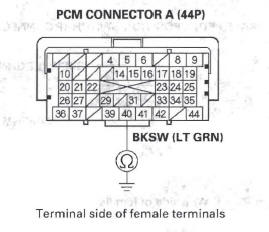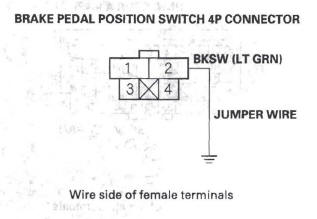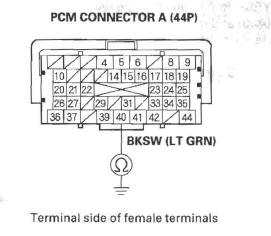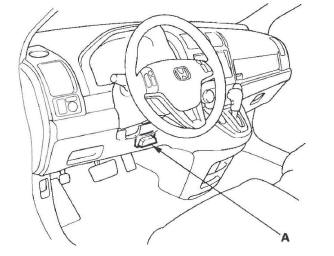Honda CR-V: Brake Pedal Position Switch Signal Circuit Troubleshooting
1. Turn the ignition switch ON (II).
2. Check the BRAKE SWITCH in the DATA LIST with the HDS.
Does it indicate OFF? YES-Go to step 3.
NO-Inspect the brake pedal position switch.
3. Press the brake pedal, and check the BRAKE SWITCH in the DATA LIST with the HDS.
Does it change to ON? YES-The brake pedal position switch signal circuit (BKSW line) is OK.
NO-Go to step 4.
4. Turn the ignition switch OFF.
5. Jump the SCS line with the HDS.
6. Disconnect the brake pedal position switch 4P connector.
7. Disconnect PCM connector A (44P).
8. Check for continuity between PCM connector terminal A40 and body ground.

Is there continuity? YES-Repair short in the wire between the PCM (A40) and the No. 12 HORN, STOP (15 A) fuse.
Replace the No. 12 HORN, STOP (15 A) fuse.
NO-Go to step 9.
9. Connect brake pedal position switch 4P connector terminal No.2 to body ground with a jumper wire.

10. Check for continuity between PCM connector terminal A40 and body ground.

Is there continuity? YES-Repair open in the wire between the brake pedal position switch and the No. 12 HORN, STOP (15 A) fuse. Inspect the brake pedal position switch.
NO-Repair open in the wire between the PCM (A40) and the brake pedal position switch.
Idle Speed Inspection
NOTE:
- Before checking the idle speed, check these items:
- The malfunction indicator lamp (MIL) has not been reported on, and there are no DTCs.
- Ignition timing
- Spark plugs
- Air cleaner
- PCV system
- Apply the parking brake (check the headlight OFF).
1. Disconnect the evaporative emission (EVAP) canister purge valve connector.
2. Connect the HDS to the data link connector (DLC) (A) located under the driver's side of the dashboard.

3. Start the engine. Hold the engine speed at 3,000 rpm without load (in Park or neutral) until the radiator fan comes on, then let it idle.
4. Check the idle speed without load conditions: headlights, blower fan, radiator fan, and air conditioner off.
Idle speed should be: 650+-50 rpm (in Park or neutral)
5. Let the engine idle for 1 minute with high electric load (A/C switch on, temperature set to max cool, blower fan on High, and headlights on high beam).
Idle speed should be: 700+-50 rpm (in Park or neutral)
NOTE: If the idle speed is not within specification, do the PCM idle learn procedure.
If the idle speed is still not within specification, go to symptom troubleshooting.
6. Reconnect the EVAP canister purge valve connector.
PCM Idle Learn Procedure
The idle learn procedure must be done so the PCM can learn the engine idle characteristics.
Do the idle learn procedure whenever you do any of these actions:
- Replace PCM.
- Reset PCM.
- Update PCM.
- Replace or clean the throttle body.
- When the engine or transmission is disassembled.
NOTE: Erasing DTCs with the HDS does not require you to do the idle learn procedure.
Procedure
1. Make sure all electrical items (A/C, audio, lights, etc.) are off.
2. Reset the PCM with the HDS.
3. Turn the ignition switch ON (II), and wait for 2 seconds.
4. Start the engine. Hold the engine speed at 3,000 rpm without load (in Park or neutral) until the radiator fan comes on, or until the engine coolant temperature reaches 194 F (90 ºC).
5. Let the engine idle for about 5 minutes with the throttle fully closed.
NOTE: If the radiator fan comes on, do not include its running time in the 5 minutes.
6. Verify on the HDS data list that the idle learn procedure is complete.

